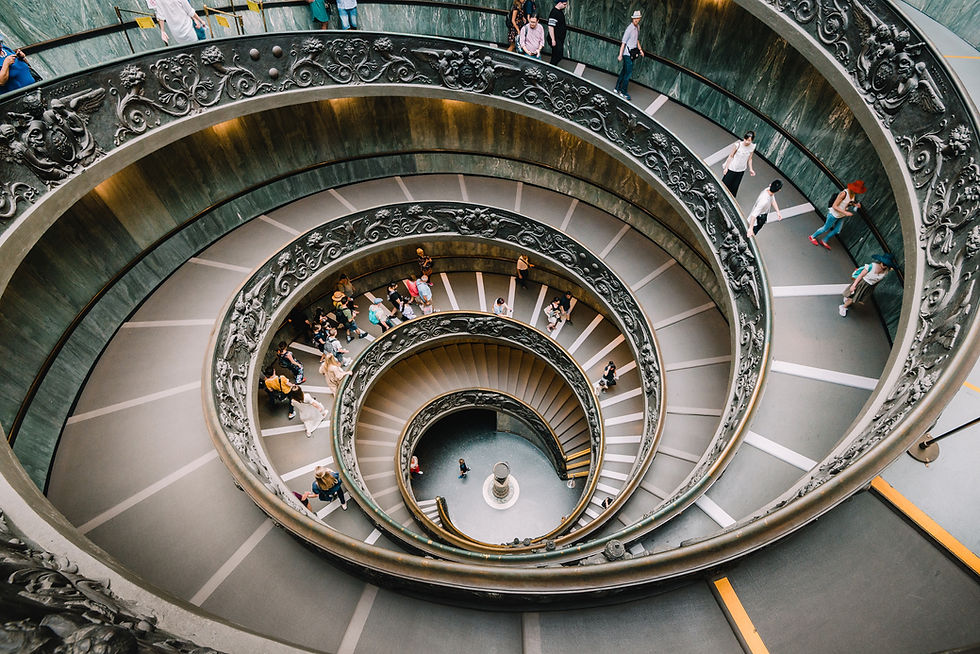Can Retail Go Circular?
- Juli Lassow

- Jul 20, 2020
- 4 min read
Updated: Nov 2, 2023

I’ve been in love with the idea of the Circular Economy ever since I first heard about it.
Zero waste.
Closed system.
So simple, clean, and alluring.
As someone who’s spent her professional life in retail, I had to wonder: Could the Circular Economy be THE breakthrough? Could it help us talk more compellingly about sustainability and accelerate progress on the issue?
Now, as much as I loved working in retail—mass retail, to be specific—something never sat quite right with me. Arguably, I helped to make lots of stuff people didn’t need, and I was also supporting industries that disproportionately harmed the environment and other businesses. That trend showed no sign of reversing. And the world was noticing.
When I met the man who would become my husband, the book he was reading was—no joke— Big Box Swindle.
I thought, “Whoa . . . this isn’t going to work out well.”
Lucky for me, I was dead wrong.
Still, I often felt I had to defend my retail career with others. I’d be at parties talking about work, and people would say, “So, you’re in retail, huh?” (Cue the big shudder now.) And in my head, I’d immediately translate that to: “Why do that when you could be getting the world to be more dependent on solar energy? Or teach the next generation how to appreciate science and music?”
Oof. It was hard to take.
But hey, a job is a job, and as I said, I loved mine. I told myself (and others) that I was in retail to make better stuff. Better stuff with better partners. With better-created value. That pep talk worked until it didn’t.
When I launched my consulting practice, one of my goals was to multiply the “better.” I was determined to bring together the best partners to make better products with less harm to the environment.
And for the most part, I’ve been able to do that.
But a voice in my head kept insisting that retail needed to do much more to protect the environment, reverse the downward trend, and make—excuse the pun—a more sustainable impact.
Then the Circular Economy arrived on the scene, and I thought, “Yes, this is it!” This is how we can make sustainability “work” for retail. This is how we measure it—with a valid sustainability index –– and not “greenwash” the results by touting meaningless statistics like “made with 70% less water.”
Like others who wanted to learn more, I came across the Ellen MacArthur Foundation and continued to discover how simple, elegant, and clean the Circular Economy could be. At least in theory.
Then, the buzz around all things circular continued to grow, with a slew of articles asking questions such as, “Is This the Year for Retail Sustainability to Catch On?” and proclaiming that “Gen Z Commits to Pay More for Sustainable Goods.”
I even started talking to my friends about it. “I think I’ve seen the future of sustainability,” I’d say, “And it’s amazing . . . it’s called the Circular Economy.”
And my friends would respond, “Go on, tell us more!”
The trouble was, I couldn’t.
You see, I had only scraped the surface of the Circular Economy. As I said earlier, I was in love with the idea of it but didn’t know how it worked—or if it was even feasible for retailers to become fully circular.
I decided to learn more. I scoured the Internet for information, shared articles on LinkedIn (#circulareconomy), and watched Tedx Talks (35 and counting).
But in the back of my head, I started to get nervous.
True retail circularity?
That was going to be tough.
Really tough. All those suppliers. All those products. All that transportation. All that waste. And oh yeah, all those consumers, too. There were so many groups to convince and convert, so many circles to create. I had to stop and ask myself: Was going circular yet another “green” pipe dream?
However, I took some inspiration from the Netherlands, which has already committed to becoming circular by 2050. No one’s quite sure how they’ll do it, but the government has already planned to enact legislation and provide help to businesses. No doubt, there’s something real brewing here...
And then—boom!—my tipping point arrived last week. The mighty Amazon (!) had become a member of the Ellen MacArthur Foundation partner network, joining this fantastic list of retailers and brands. Which made me wonder: If Amazon thinks they can go circular, then is this when the movement begins to take off?
Move from the theoretical to the mainstream? From a special project to a fully-embraced system?
Who else would be able to make the transition? Mass retailers? Drug store chains? Main Street stores?
But I also wonder: When retail is struggling fiercely to respond to COVID-19 (and whatever may follow it), how serious would it be to commit real time, energy, and resources to the Circular Economy?
No question about it, those headwinds are blowing strong. But they’re also creating a clearing to build something new and extraordinary. Yes, it may finally be time for retail to make—dare I use the clichéd term—its long-awaited “pivot.”
So today, I’m launching an exciting new effort: an investigation into retail and the Circular Economy. More specifically, I’m champing at the bit to find out three things:
First, is the circular approach even viable in our industry?
And second, if it is, what are the examples and models available for us to follow?
Last, and arguably most important, how can we get past mere talk and models—and get down to taking some real action?
A quick Google search tells me there are already 90,000,000 items on the internet debating these very issues.
I’m ready to dive in and discover. I hope you are, too.

Comments